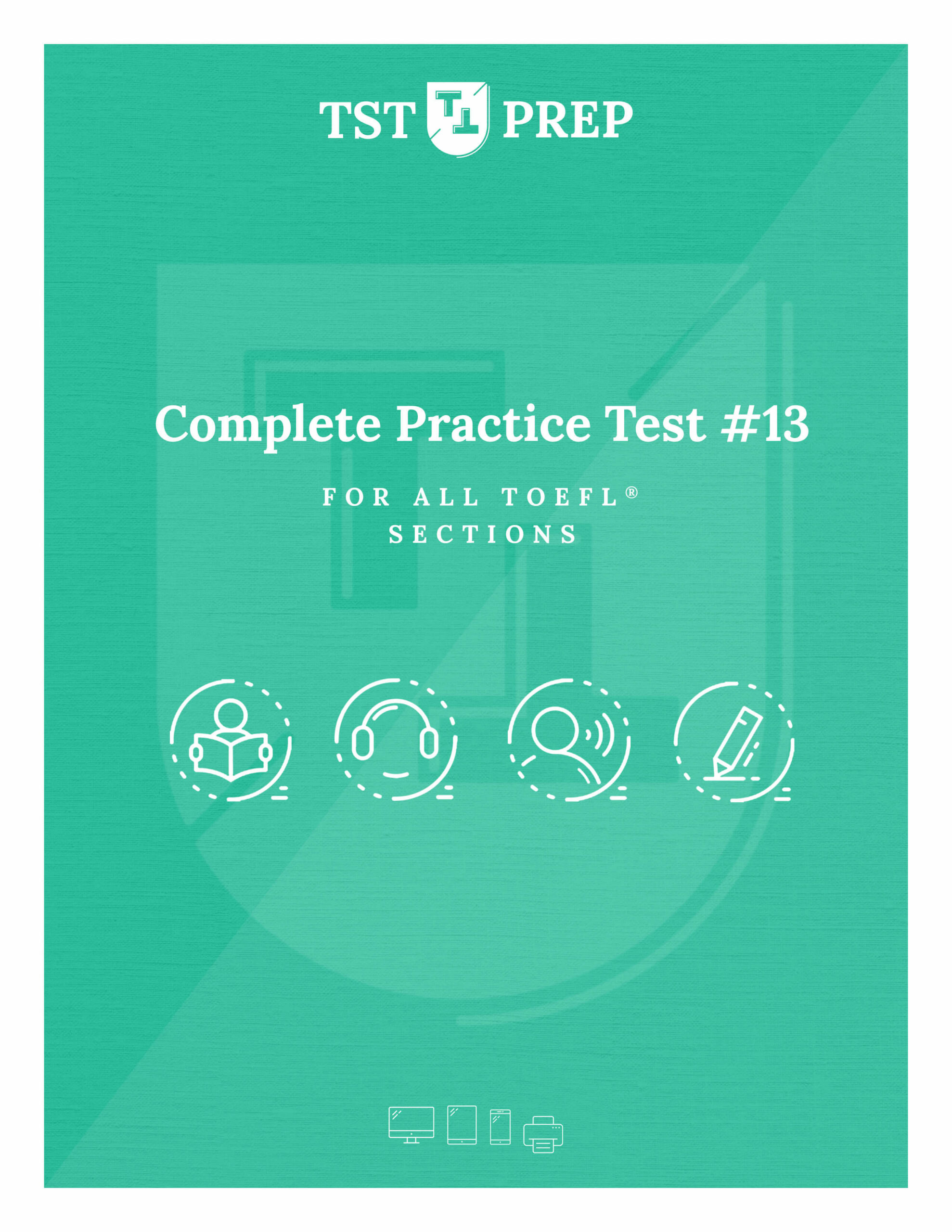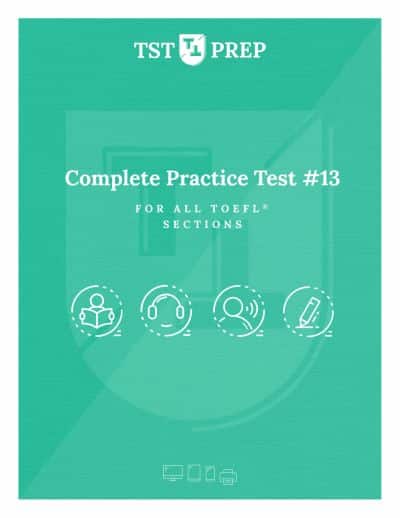If you struggle with TOEFL Summary questions in the reading section, you’re not alone.
They come at the end of almost every passage and unlike other TOEFL question types, you have to find three correct answers, not just one.
In this article, we’ll walk you through how to answer TOEFL Reading summary questions step-by-step. We’ll show you how to recognize a prose summary question, how to manage your time, and how to eliminate incorrect choices.
We’ll also reveal how to find the correct answers without even reading the passage!
To do all this we need to look at some examples of actual TOEFL Reading summary questions.
The fastest and easiest way to your TOEFL score is through practice. Use this free Complete TOEFL Practice Test #13
We are going to take a look at the summary question from the third passage, entitled Speciation.
In just ten short minutes, you will have a step-by-step process that will reduce confusion and keep you focused so you can answer any TOEFL Reading summary question.
Here's how to answer summary questions:
TOEFL Summary Questions… Summary
We are going to get into the step-by-step system in one minute. First, let’s make sure we are on the same page.
Here is a quick rundown of the most important points to consider when thinking about how to answer summary questions:
- Expect 1-2 TOEFL Reading summary questions on test day
- Located at the end of all questions for a given text
- Worth two points (most other questions are worth only one)
- Allocate between 2-3 minutes to answer each (more about this in our Time Management article)
Now that you know a little about the question itself let’s practice answering one together.
Step 1 – Identify it as a summary question
One way to help you save time when answering TOEFL Reading summary questions is to skip the directions.
Really!
The instructions are always the same. Summary questions are always worded like this:
“An introductory sentence for a brief summary of the passage is provided below. Complete the summary by selecting the THREE answer choices that express the most important ideas in the passage. Some sentences do not belong in the summary because they express ideas that are not presented in the passage or are minor ideas in the passage. This question is worth 2 points.”
Take the time to read and understand these directions carefully, so you can skip them on test day. You want to conserve your time and direct your focus to the actual question.
Step 2 – Read the topic sentence and figure out the main idea
Now you know how to identify TOEFL Reading summary questions. Besides the fact that they are the very last question of a given reading passage, they also always have the same directions.
Let’s look at an example from the passage Speciation, which is text #3 in the TOEFL Reading section of TST Prep Test #11.
10. DIRECTIONS: An introductory sentence for a brief summary of the passage is provided below. Complete the summary by selecting the THREE answer choices that express the most important ideas in the passage. Some sentences do not belong in the summary because they express ideas that are not presented in the passage or are minor ideas in the passage. This question is worth 2 points.
For over a century, biologists have been trying to understand and define the mechanisms for speciation.
a. The definition of species is a group of organisms that have the capacity to interbreed.
b. Scientists have organized the mechanisms for speciation into two categories: allopatric and sympatric.
c. In his On the Origin of Species, Darwin theorized that the speciation process was a branching event.
d. The formation of a new branch of a river is an example of an event that leads to allopatric speciation.
e. Certain species, like flying species, can carry-on multiple gene pools as they travel between populations.
f. The second category of speciation mechanisms states that speciation can occur when individuals live and breed in the same location.
Since the directions are always the same, let’s cut them out and concentrate on the question.
For over a century, biologists have been trying to understand and define the mechanisms for speciation.
a. The definition of species is a group of organisms that have the capacity to interbreed.
b. Scientists have organized the mechanisms for speciation into two categories: allopatric and sympatric.
c. In his On the Origin of Species, Darwin theorized that the speciation process was a branching event.
d. The formation of a new branch of a river is an example of an event that leads to allopatric speciation.
e. Certain species, like flying species, can carry-on multiple gene pools as they travel between populations.
f. The second category of speciation mechanisms states that speciation can occur when individuals live and breed in the same location.
Here comes the fun part!
We are going to start eliminating choices without even reading the passage.
Instead of reading the passage, we are going to focus on the topic sentence and figure out the main idea.
Topic sentence: For over a century, biologists have been trying to understand and define the mechanisms for speciation.
Try to simplify that sentence in a way that even a ten-year-old would understand.
Identifying keywords can help a lot.
Keywords are the most important words in a given sentence. They are usually either nouns or verbs.
Anyway…
Simple Topic Sentence: Biologists have been trying to understand speciation for awhile.
This is the most important part of the entire step-by-step process of how to answer TOEFL Reading summary questions. Proper identification of the main idea of the topic sentence is going to guide you to the correct answers.
More on this in step three.
Let’s go through each possible choice together. When analyzing an option, ask yourself: Does this directly relate to the topic sentence?
Step 3 – Eliminate choices that are not directly related to the topic sentence
Again, we are only focusing on the topic sentence, not the passage itself. We are going to use it to guide what options we choose and what we eliminate.
Simple Topic Sentence: Biologists have been trying to understand speciation for awhile.
a. The definition of species is a group of organisms that do or could interbreed
I am immediately suspicious of this choice because it is a definition of species, and has nothing to do with speciation.
I eliminate a.
Simple Topic Sentence: Biologists have been trying to understand speciation for awhile.
b. Biologists have organized the mechanisms for speciation into two categories, allopatric and sympatric.
That choice looks pretty good. It is directly related to speciation and elaborates on it without getting into too much detail.
I keep b. (Note that I am not making any final decisions at this stage, only eliminating choices I suspect are incorrect.)
Simple Topic Sentence: Biologists have been trying to understand speciation for awhile.
c. In his On the Origin of Species, Darwin theorized that the speciation process was a branching event.
I’m not sure about this one. Speciation is mentioned, but it is also referring to Darwin’s book.
I keep c.
Simple Topic Sentence: Biologists have been trying to understand speciation for awhile.
d. An example of an event that leads to allopatric speciation is the formation of a new branch of a river.
While this sentence is about speciation, it seems to be a bit too detailed for a summary response.
I keep d…for now.
In step four I will have a chance to review these options again.
Simple Topic Sentence: Biologists have been trying to understand speciation for awhile.
e. Certain species, like flying species, can carry-on multiple gene pools as they travel between populations.
This choice is a specific example of a species and how it transfers genes. This does not appear to be connected to the topic sentence.
I eliminate e.
Simple Topic Sentence: Biologists have been trying to understand speciation for awhile.
f. The second category of speciation mechanisms states that speciation can occur when individuals live and breed in the same location.
This option looks good. It is connected to the topic sentence and doesn’t include too many details.
I keep f.
Note that there will be times when you look at a topic sentence and can’t eliminate a single possible choice. That’s OK. This doesn’t work 100% of the time. This is a strategy designed to help you focus on the topic sentence and use it to select options that are connected to it.
Step 4 – Eliminate choices that seem like details
Summary questions are asking you to summarize the passage. With that in mind, be sure to eliminate options that are too specific.
For example, if there was a reading passage about my university, the subtopics might be something like:
- the university’s general history
- the university’s current student population
- the university’s degree programs
A summary would not contain specific details about each of these categories, for example:
- the university was founded in 1867
- there are currently 2,367 undergraduates
- the Creative Writing degree program includes a Creative Writing 101 Course taught by Professor Elliot on Tuesdays

Notice the difference?
Let’s go back to our question. We have already eliminated a and e.
Let’s look at b, c, d, and f to see if any sounds too much like a detail.
Simple Topic Sentence: Biologists have been trying to understand speciation for awhile.
b. Biologists have organized the mechanisms for speciation into two categories, allopatric and sympatric.
c. In his On the Origin of Species, Darwin theorized that the speciation process was a branching event.
d. An example of an event that leads to allopatric speciation is the formation of a new branch of a river.
f. The second category of speciation mechanisms states that speciation can occur when individuals live and breed in the same location.
I feel like d is a bit too detailed. I could be wrong (remember, this is a strategy and much of it is based on previous knowledge and intuition), but it sounds like a detail that would follow a paragraph about allopatric speciation, rather than an introduction to the topic.
But like I said, I could be wrong, so I leave it for now.
I still have another step to go.
Step 5 – Go back to the text (especially topic sentences)
Hey, remember how this question is supposed to be a summary of a reading passage?
We haven’t even looked at the passage yet and we have already eliminated two choices.
Below is an image of the text from Speciation from our free and complete practice test for the TOEFL, TST Prep Test #13.
Speciation
The biological definition of species, which works for sexually reproducing organisms, is a group of actually or potentially interbreeding individuals. According to this definition, one species is distinguished from another by the possibility of matings between individuals from each species to produce fertile offspring. There are exceptions to this rule. Many species are similar enough that hybrid offspring are possible and may often occur in nature, but for the majority of species, this rule generally holds. In fact, the presence of hybrids between similar species suggests that they may have descended from a single interbreeding species and that the speciation process may not yet be completed.
Given the extraordinary diversity of life on the planet, there must be mechanisms for speciation: the formation of two species from one original species. Darwin envisioned this process as a branching event and diagrammed the process in the only illustration found in On the Origin of Species. For speciation to occur, two new populations must be formed from one original population, and they must evolve in such a way that it becomes impossible for individuals from the two new populations to interbreed. Biologists have proposed mechanisms by which this could occur that fall into two broad categories. Allopatric speciation, meaning speciation in “other homelands,” involves a geographic separation of populations from a parent species and subsequent evolution. Sympatric speciation, meaning speciation in the “same homeland,” involves speciation occurring within a parent species while remaining in one location.
A geographically continuous population has a gene pool that is relatively homogeneous. Gene flow, the movement of alleles across the range of the species, is relatively free because individuals can move and then mate with individuals in their new location. Thus, the frequency of an allele at one end of a distribution will be similar to the frequency of the allele at the other end. When populations become geographically discontinuous, that free-flow of alleles is prevented. When that separation lasts for a period of time, the two populations are able to evolve along different trajectories. Thus, their allele frequencies at numerous genetic loci gradually become more and more different as new alleles independently arise by mutation in each population. Typically, environmental conditions, such as climate, resources, predators, and competitors, for the two populations will differ causing natural selection to favor divergent adaptations in each group. Different histories of genetic drift, enhanced because the populations are smaller than the parent population, will also lead to divergence.
Isolation of populations leading to allopatric speciation can occur in a variety of ways: from a river forming a new branch, erosion forming a new valley, or a group of organisms traveling to a new location without the ability to return, such as seeds floating over the ocean to an island. The nature of the geographic separation necessary to isolate populations depends entirely on the biology of the organism and its potential for dispersal. If two flying insect populations took up residence in separate nearby valleys, chances are that individuals from each population would fly back and forth, continuing gene flow. However, if two rodent populations became divided by the formation of a new lake, continued gene flow would be unlikely; therefore, speciation would be more likely.
Can divergence occur if no physical barriers are in place to separate individuals who continue to live and reproduce in the same habitat? Sympatric speciation does also sometimes take place. For example, imagine a species of fish that lived in a lake. As the population grew, competition for food also grew. Under pressure to find food, suppose that a group of these fish had the genetic flexibility to discover and feed off another resource that was unused by the other fish. What if this new food source was found at a different depth of the lake? Over time, those feeding on the second food source would interact more with each other than the other fish; therefore they would breed together as well. Offspring of these fish would likely behave like their parents and feed and live in the same area, keeping them separate from the original population. If this group of fish continued to remain separate from the first population, eventually sympatric speciation might occur as more genetic differences accumulated between them.
One enormous advantage you will have on test day is that by the time you reach the summary question, you will have read the entire passage!
The sentences highlighted in yellow are the introductory sentences to each body paragraph. They are designed to introduce a subtopic that will be elaborated on further with details in the given paragraph. The first sentence of most body paragraphs doesn’t include detailed information, which is what makes them ideal as possible summary answers.
For example, I see choice d including some of the text from the introductory sentence of the third body paragraph.
d. An example of an event that leads to allopatric speciation is the formation of a new branch of a river.
However, this doesn’t mean d is correct, only that it is more likely to be important.
All of these steps are part of a strategy. A strategy does not always lead to victory, it is only an intelligent way to get there.
In summary (pun intended!)
- Step 1 – Identify it as a summary question
- Step 2 – Read the topic sentence and figure out the main idea
- Step 3 – Eliminate choices that are not directly related to the topic sentence
- Step 4 – Eliminate choices that seem like details
- Step 5 – Go back to the text (especially topic sentences)
Now that you know how to answer TOEFL Reading summary questions, it’s time to practice.
Practicing will help solidify this new information into your memory so you can actually apply it on test day.
Confused about the TOEFL? Answer explanations, sample essays, and speaking responses are all included in this free complete TOEFL Practice test.
Or, if you feel like you want to learn more cool TOEFL Reading tips and tricks like this, check out our Ten Awesome Tips for the Reading Section of the TOEFL Test
I know this TOEFL stuff can get a bit frustrating sometimes. So don’t hesitate to reach out and let me know if you have any questions or concerns: contact@tstprep.com
Did I miss anything? Or do you have a comment?
Please add your ideas in the comments section below.
I promise to respond to every single one!











74 Comments
Sandra
Thank you so much for the article. I always struggle with the summary questions and I feel more confident now after reading the strategies.
Josh
That’s great news Sandra. We get a lot of questions about summary questions so I figured it would be a good idea to write an article about it.
Good to hear you found it helpful! Let me know if there’s anything we should cover in the future.
Keren
Thanks so much
I was not able to answer summary question on reading but i think now i can.
Josh
That’s great to hear Keren!
Nouran
Thank you so much for this resource
I have a question though
While I was doing some of your practice packets one of the summery questions topic sentence was :Various elements have been grouped in a table based on their physical properties and periodic relationship thanks to a few chemists.
Well I put one of my answers as:The names of two of the most prominent chemists for their work on the periodic table are Dimitri
Mendeleev and Lothar Meyer
because this supports the statement made in the topic sentence when it talks about “few chemists”
I still don’t understand why this is wrong even after reading the explanation
Josh
thanks for the comment Nouran, but I’m not sure which question you are referring to. If you could send me the link with the comment to josh@tstprep.com I can take a deeper look at this issue.
Thanks for reading 🙂
Santosh
Amazing! I love it
Josh
Thank you Santosh! Happy to help 🙂
Lorena
Thank you so much. I was having a difficult time with this type of questions, even after practicing.
I could not find information on how to approach them anywhere else!
Josh
That’s great news Lorena and happy we can help. Don’t hesitate to let us know if there are any TOEFL topics we should write about in the future.
Ali
Thanks a lot for sharing this point
Josh
Thanks for taking the time to read Ali. Happy to hear you found it helpful.
Sadiq
Thank you Sir for sharing such invaluble things with us. I was wondering if it would be possible to provide us with more tips and instruction on Paraphrasing ( simplyfying the Topic Sentence and getting the Main Idea).
This would result in better understanding of correct answer choices.
Josh
Hi Sadiq and great question. We are currently updating our Mastery course, but in the meantime, you can check out this guide to paraphrasing questions, which you may find helpful, https://drive.google.com/open?id=1Wn5Wy4tWP0ADrG4AM6SKMy7U_uzStN8V
Anne Jean
Thank you very much for all the tips. I have learned so much with you and your help make me feel more confident about my upcoming examen. Thank you very much sir for such help.
Josh
Anne Jean, thank you so much for taking the time to leave such a nice comment. I’m happy to help and good luck with your exam!
Arzi Akhgar
It was fruitful!
Thanks!
Josh
Hi Arzi and thank you for taking the time to leave a comment. Much appreciated 🙂
Nathanael Lulandala
Thank you for your response to me and your offer of free material. It helps me much to advance my preparation. I hope to study hard as to increase my TOEFL scores
Josh
No problem and good luck 🙂
Pooja Bhattacharya
Thank you so much sir
Josh
Thank you for leaving a comment! Much appreciated 🙂
Paris
Awesome! :))))
I’m able to answer those tricky questions now.
thank you
Josh
That’s great news Paris! Let me know how it works out for you 🙂
Englay
I have never heard about this strategy. Thank you.
Josh
No problem Englay. I hope it helps. Let me know how it works for you 🙂
Karima
Thank you so much for sharing this i never heard of it but its making things look much more easier ! Thanks really appreciate it.
Josh
No problem Karima and thanks for commenting. I’m happy to hear you found it helpful.
Alireza Pourdastmalchi
Thanks for your website.
Have you tried this techniques on real exam questions?
The first sentence is not usually a long complete topic sentence for the summary paragraph. Sometimes it is only one short sentence without giving you any general clues, like the one you used as an example here.
The other thing is that, if you are supposed to go back to the reading and check, why do you wanna bother yourself using trial and error and choose based on your intuition? Don’t you think this technique is pretty time-consuming? On the one hand this technique is implying that you don’t need to comprehend the passage fully, on the other hand you are telling that at some point we have to go back and check the passage.
I don’t mean to be critical. I am just trying to find the best technique that makes sense for this question type.
Josh
Hi there and thank you for your thoughtful comment.
To your first point: “The first sentence is not usually a long complete topic sentence for the summary paragraph”
Here is the summary sentence in the article: “Since at least Darwin’s time, biologists have been trying to understand and define the mechanisms for speciation.”
Like all sentences, it contains a subject, verb, and object (biologists/understand/speciation). No matter what the length of a sentence it will provide information that you can use to help you answer the question.
To your second point: “On the one hand this technique is implying that you don’t need to comprehend the passage fully, on the other hand you are telling that at some point we have to go back and check the passage.”
This is advice and strategy, it is not “law”. The point of providing TOEFL takers with multiple strategies is to experiment and find the approach that works best for you. Maybe you think the original strategy is too “time-consuming”, so you would want to look back at the passage instead.
There is no “one way” to approach these questions, this is just advice based on experience.
I hope that clarifies things for you.
Ildiko
Thank you so much for the summary question explanation. So far it was the hardest question for me, impossible in 1 minute 30 second
Josh
Yeah, it is tough. I’ve given this advice so often that I figured I would make a blog post out of it. Almost everyone struggles with this question type (including me!).
Josh
Sure thing! contact@tstprep.com
Nishi
heyy Joshh!!!
It was really helpful!!
i will try this strategy from now in my summary question !!!
Josh
Thank you for letting me know Nishi! I hope it helps 🙂
Sayling
Thank you so much! You are amazing. There is not a single content that you are not able to explain it clearly, going straight ahead to the important points. God bless you.
Josh
Wow, this is one of the nicest comments I’ve ever received. Thank you so much Sayling!
Erfan
Dear Josh,
you are the best teacher really.. that’s unbelievable! I have been doing accurately.
I would like to know, Do you have some other techniques in the TOEFL as the same?
Josh
Hi Erfan and thank you for your kind words. Much appreciated 🙂
I am currently working on a complete TOEFL course that will be available in September that includes all my little tricks and tips. Until then, you can check out our best strategies in the TOEFL Emergency Course – https://tstprep.com/toefl-store/toefl-emergency-course/
Caroline Gaudeoso
Thank you so much for that!! Your material is too good. Best TOEFL teacher!!
Josh
Thank you so much for your kind words, Caroline! I appreciate it 🙂
Khadija
I found TST reading preparation material Very close to actual exam. In particular, purpose questions are of same complexity. Thank you so much for being here for us.
Josh
Thank YOU so much for being kind enough to leave a nice comment!
Sarah
These points are awesome and out of the world. I appreciate your work sir. Previously I was not able to answer this type qustions now it seems much much easier.
Josh
That’s great to hear Sarah, glad you found them helpful 🙂
Ajay
Thank you so much for the Step-by-Step Guide.
Very helpful.
Josh
Thanks for commenting Ajay 🙂 – Happy to hear it helped.
Heejin Jo
wow awesome!!! Thank you sosoooooo much!!!
Zahra
Hi,
If we choose two answers correctly, we would gain the summery score or not?
Josh
Great question! The Summary question in the TOEFL Reading is the only question worth 2 points, so if you got 2/3 correct you would still get 1 point. However, if you get 1/3 or 0/3 it is a 0. I hope that answers your question!
Blba
Hey, it’s 2024 now. I am not sure if anything has changed, but my teacher says that if you get 2/3 correct, you still get 2 points. Is that wrong?
Josh
No, that is not correct. 2/3 is half credit or one point.
Sophie
Hi Josh,
first of all thank you for this great guidance! It was of great help though one thing remains unclear to me. Do I have to put the answers in the correct order as well?
Thank you for your help in advance!
Josh
Hi Sophie and I should have mentioned this somewhere in the article since many students have the same question. No, the order does not matter.
Hamid
HI,
just wanted to ask you the order of the answers matter or not?
Josh
Good question. No, the order does not matter.
Désiré Tossoukpe
Grateful!
Hazal Didem Yener
This has been really helpful. I have recently scored 106 on an online TOEFL test that I purchased. R 23, L 26, S 28, R 28. This has been my lowest so far. It’s always the summary questions that I have the most difficulty with.
Josh
Hi there Hazal and thank you for sharing your experience. The TOEFL Reading summary questions are always tricky (but your reading score is still amazing!)
Ema
Thanks for all the comments and tips – they are most useful and enjoyable to read! Pithy stuff!!
Maria
Is the order important? I mean, if I summarize this like CBF, would it be an error?
Josh
Great question Maria. No, the order does not matter. Just choose the correct options.
Sam
Would we gain the summary score if we choose two answers correctly, and one incorrect? Is there any penalty for a wrong answer?
Josh
Thank you for your question. Each Summary question is worth two points. If you get two out of three answers correct, you will get one point.
Sarabghanem
There was a summary question that we had to distribute the answers into two categories. Does that kind of question exist in the new TOEFL?
Josh
The question you are talking about is called Fill in the Table. It is still part of the test but is much less common than the Summary question. Most likely, you will get two summary questions. However, getting one fill-in-the-table question is still possible.
Negin
Hi,
First of all, I am really delighted because your explanations were incredibly useful. But I have a question: how should we answer those questions? Could you please explain it?
Josh
Hi Negin. I am happy you found the explanation useful. I am not sure I understand your question because the guide you are asking about details the steps to follow to answer summary questions. Is there a part of the guide that is unclear? Were you asking about another question type? Please let me know and I will be happy to assist as best as I can.
Cecilie
Hi Josh,
I am wondering about this as well as Negin.
Do the three sentences you choose have to be in the right order?
I’ve taken the TOEFL once before, and in the summary question, you’re given the topic sentence and then the three blank spaces where you can “drag” your answers to. I wonder if I’d get the answer to the speciation summary question wrong if I had put F, C, and B (instead of B, C and F as you did). I hope this makes sense!
Josh
Great question. They can be in any order. 🙂
Aditya
Hi Josh,
This article is fabulous! It helped me a lot. I was wondering if there are any more such articles related to other question types of TOEFL reading.
Josh
Sure! Try these 🙂
https://tstprep.com/articles/toefl/time-management-for-the-reading-section-of-the-toefl-test/
https://tstprep.com/articles/toefl/ten-awesome-tips-for-the-reading-section-of-the-toefl-test/
هات بت
It’s nearly impossible to find experienced people in this particular topic, however, you seem like
you know what you’re talking about! Thanks
Josh
Thanks for taking the time to comment. It means a lot!